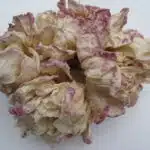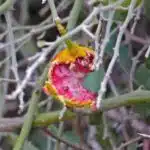Roses are some of the most beautiful and popular flowers in the world. Many gardeners take pride in cultivating healthy, vibrant roses that bloom with colorful blooms. However, achieving this goal requires a thorough understanding of how to properly fertilize roses.
Fertilizing roses is a critical aspect of maintaining their health and beauty. A well-fertilized rose bush will produce larger and more abundant blooms, while also resisting pests and diseases. In this article, we will explore the various methods for fertilizing roses to ensure that your bushes are healthy and visually stunning all season long. Whether you are an experienced gardener or just starting out, the information provided here will help you achieve optimal results with your rose garden.
The Importance Of Fertilizing Roses
As a horticulture expert, understanding the importance of fertilizing roses is crucial for growing beautiful and healthy bushes. Fertilizers provide essential nutrients that plants need to grow and develop properly. Without proper fertilization, roses may experience nutrient deficiencies which can lead to stunted growth, yellowing leaves, and poor flower production.
The benefits of fertilizing are numerous. Firstly, it helps improve soil fertility by adding essential minerals that plants require to thrive. Secondly, it improves the growth rate of roses by providing them with the necessary nutrients for photosynthesis and energy production. Lastly, it enhances the quality and quantity of blooms produced by roses.
Signs of nutrient deficiency in roses can manifest in different ways depending on the specific nutrient lacking in the soil. For example, nitrogen deficiency causes yellowing leaves while potassium deficiency leads to weak stems and poor flower development. It is important to diagnose these deficiencies early on to ensure proper treatment through timely fertilization.
Understanding the nutrient needs of roses is crucial for successful fertilization. In the following section, we will explore the specific macronutrients and micronutrients required by roses for optimal growth and bloom production.
Understanding The Nutrient Needs Of Roses
As we discussed in the previous section, fertilizing roses is crucial for beautiful bushes. However, not all fertilizers are created equal, and it is essential to understand the nutrient needs of roses to provide them with the right balance of nutrients. One way to determine if your roses are lacking in certain nutrients is by observing signs of nutrient deficiencies.
Yellowing leaves with green veins may indicate a lack of iron or nitrogen, while yellow leaves without green veins may suggest a lack of magnesium. Stunted growth and small leaves can also be signs of nutrient deficiencies. Once you have identified the specific nutrient deficiency, you can adjust your fertilizer accordingly.
It’s important to note that different stages of rose growth require different amounts and types of nutrients. For example, during the early growth stage, roses need more nitrogen for foliage development. During the flowering stage, they require more phosphorus to support bloom production. Adjusting your fertilizer application based on these stages will ensure that your roses receive the appropriate balance of nutrients at each stage.
Understanding the nutrient needs and identifying nutrient deficiencies in your roses will help you choose the right fertilizer for their specific requirements. In the next section, we will discuss how to choose the right fertilizer for your roses to maximize their growth and beauty.
Choosing The Right Fertilizer For Your Roses
When it comes to maintaining healthy and beautiful roses, fertilization is crucial. Choosing the right fertilizer for your roses can make all the difference in how they grow and bloom. There are many factors to consider when selecting rose fertilizer, such as the soil type, climate, and specific nutrient needs of your plants.
Firstly, it is important to select a fertilizer that is specifically designed for roses. These fertilizers are formulated with the necessary nutrients that roses need to thrive, including nitrogen, phosphorus, and potassium. Additionally, look for a fertilizer with a high percentage of organic material, which will help improve soil quality and promote healthy root growth.
Secondly, consider your specific rose variety when choosing a fertilizer. Different types of roses have different nutritional needs. For example, hybrid tea roses often require higher levels of nitrogen than other varieties. It is also important to take into account the age of your plants; younger plants may benefit from higher levels of phosphorus for strong root development.
Lastly, think about the time of year when applying fertilizer. In general, it is recommended to fertilize roses in early spring before new growth appears and again in late summer after the first bloom cycle has ended. Avoid fertilizing during hot summer months or during periods of drought.
In summary, choosing the right fertilizer for your roses requires consideration of various factors such as plant variety and nutrient requirements. By selecting a high-quality rose-specific fertilizer with organic material content that meets your plant’s nutritional needs at the right time during peak growing seasons you can provide optimal growing conditions for healthy blooms! Next up we’ll discuss some organic fertilizer options that you may want to consider adding to your routine maintenance plan!
Organic Fertilizer Options
- Compost is a well-known natural fertilizer derived from decomposing organic matter, making it an excellent organic fertilizer option for roses.
- Manure is also an effective organic fertilizer, either in its raw form or as composted manure, and can be applied to roses to promote healthy growth and improved flowering.
- Bloodmeal is a natural source of nitrogen, phosphorus, and potassium, making it an effective organic fertilizer for roses.
- Bone meal is a great source of phosphorus and calcium for roses, and can be used to promote strong roots and improved blooming.
- Fish emulsion is an organic fertilizer that is high in nitrogen and can be used to promote lush foliage growth for roses.
- Epsom salt is a source of magnesium and sulfur, which are both essential for healthy rose growth, and can be used as an organic fertilizer option.
Compost
Compost is a crucial component in organic gardening, especially for rose bushes. Composting methods involve using organic matter that has decomposed to create a nutrient-rich soil amendment. The composting process breaks down the materials, turning them into a dark, crumbly substance that can be added to the soil around roses.
Composting materials include kitchen scraps like vegetable and fruit peels, eggshells, and coffee grounds. Yard waste such as leaves, grass clippings, and small twigs can also be used in composting. Adding manure from cows or horses can speed up the decomposition process and add additional nutrients to the compost.
To make compost, you will need to layer your materials in a pile or bin. Moisture levels should be maintained by adding water as needed. Temperature is also important to consider because it affects how quickly the composting process occurs. Turning the compost regularly will help mix all of the materials together and speed up decomposition.
In conclusion, creating your own compost is an excellent way to provide your roses with natural and rich nutrients for optimal growth. With various composting methods and available materials, making your own fertilizer doesn’t have to be complicated or expensive. By incorporating compost into your gardening routine, you are not only improving the health of your roses but also doing your part in reducing waste going into landfills.
Manure
Manure is a common organic fertilizer option for rose bushes. It contains essential nutrients like nitrogen, phosphorus, and potassium that are necessary for plant growth. Applying manure to your roses can also help improve soil structure and water-holding capacity. However, it’s important to note that not all types of manure are created equal. Some may contain high levels of salts or harmful pathogens that can damage your plants.
One of the benefits of using manure in your compost pile is that it can speed up the decomposition process. Manure contains microorganisms that break down organic matter more quickly than just using leaves or grass clippings alone. It’s recommended to use aged or composted manure in your garden beds as fresh manure can burn and damage plants. When applying manure to your roses, be sure to mix it into the soil thoroughly and avoid direct contact with the plant stems.
Another tip when using manure as a fertilizer for roses is to choose the right type of animal waste. Cow and horse manure are commonly used in gardening because they have a balanced nutrient profile and don’t contain as many weed seeds as other types of manure. Chicken or bird droppings are high in nitrogen but may need to be composted first before use due to their high ammonia content. Always check with your local extension office or gardening expert for advice on how much and what type of manure is best for your specific growing conditions.
Bloodmeal
Another organic fertilizer option for rose bushes is bloodmeal. It is a high-nitrogen fertilizer made from dried and powdered animal blood, usually from cows or pigs. Bloodmeal has several benefits for plant growth, including promoting healthy green foliage and stimulating root development. Additionally, it can help attract earthworms, which can improve soil structure and nutrient availability.
When applying bloodmeal to your roses, it’s important to follow the recommended application rates as too much nitrogen can lead to excessive foliage growth at the expense of flower production. As a general rule of thumb, use 1-2 tablespoons per rose plant every 4-6 weeks during the growing season. Bloodmeal can be mixed into the soil around the base of the plant or applied as a top dressing.
For best results, apply bloodmeal in early spring before new growth starts or in late fall after the last blooms have faded. Avoid using bloodmeal during hot weather or when plants are experiencing drought stress as this can increase the risk of leaf burn. As with any fertilizer, be sure to water the plants well after application to prevent nutrient burn and help nutrients reach the root zone.
Synthetic Fertilizer Options
In contrast to organic fertilizers, synthetic fertilizers are made from chemically produced nutrients that provide a more immediate source of plant food. They can also be formulated to deliver specific nutrients crucial for plant growth and development. Synthetic fertilizers come in two options: slow-release or water-soluble.
Slow-release synthetic fertilizers supply plants with nutrients over an extended period of time, which reduces the need for frequent applications. These types of fertilizers usually last between 8-10 weeks before requiring additional applications. Slow-release fertilizers are typically granular and contain sulfur-coated urea or polymer-coated materials designed to break down slowly in the soil, releasing the nutrients gradually.
Water-soluble synthetic fertilizers dissolve quickly in water and are easily taken up by plants through their roots. These types of fertilizers require more frequent applications than their slow-release counterparts but provide a quicker response from plants. Water-soluble synthetic fertilizers are usually in liquid form and can be applied directly to the soil or foliage through irrigation systems or foliar sprays.
The choice between synthetic and organic fertilizer ultimately depends on individual preferences and requirements. While each option has its advantages and disadvantages, it is important to note that using too much synthetic fertilizer can lead to environmental issues such as groundwater pollution. In the next section, we will discuss liquid versus granular fertilizers and how to choose the right one for your roses.
Liquid Vs. Granular Fertilizers
Fertilizing roses is like feeding a newborn baby. You want to make sure you are giving your rose bushes the right type of food, at the right time, and in the right amounts. Liquid and granular fertilizers are two types of plant food that can be used for roses. Both have their advantages and disadvantages, and choosing between them depends on various factors.
Liquid fertilizers are fast-acting, meaning they provide a quick boost to plants. They are easily absorbed by the roots and foliage, making them an excellent choice for roses that need a quick pick-me-up. Liquid fertilizers come in various forms such as concentrated solutions or slow-release formulations. While they are easy to apply using spray bottles or watering cans, they can also be costly in the long run due to frequent application methods. Furthermore, liquid fertilizers have a high environmental impact due to their potential runoff into waterways.
On the other hand, granular fertilizers release nutrients slowly over time, which makes them ideal for long-term maintenance of rose bushes. They come in different strengths and formulations that cater to specific plant needs. Granular fertilizers are easy to apply by spreading them over the soil surface around plants’ bases or mixing them into the soil before planting roses. They are cost-effective since they require fewer applications than liquid fertilizers but take longer to show results. However, improper application methods can lead to nutrient leaching or runoff contributing to environmental pollution.
When it comes down to choosing between liquid and granular fertilizer options for your rose bushes, there is no one-size-fits-all answer as it depends on individual requirements such as availability, budget constraints, application methods preferred and environmental concerns. It is essential first to determine your priorities before deciding which type of fertilizer is best suited for your garden’s specific needs. Next up will be discussing when is the best time to fertilize roses based on various factors that affect plant growth cycles throughout its lifespan.
When To Fertilize Roses
Fertilizing roses is a crucial step in maintaining their health and beauty. However, applying fertilizers at the wrong time can damage the plants or result in weak flower production. Therefore, it is essential to know when to fertilize your roses.
The best time to fertilize roses is in early spring when new growth appears. At this point, the roses are coming out of their dormant stage and require nutrients to fuel their growth. It is recommended that you apply an all-purpose fertilizer with balanced nutrients such as nitrogen, phosphorus, and potassium. Some of the best fertilizer brands for roses include Miracle-Gro Rose Plant Food and Jobe’s Organics Rose & Flower Fertilizer.
It’s important not to over-fertilize your roses as this can result in excessive foliage growth, which can attract pests and lead to disease problems. Over-fertilization may also cause yellowing of leaves or burning of roots due to salt buildup. Signs of over-fertilization include weak stems, small flowers, or leaves with brown tips. Therefore, it’s essential to follow the recommended application rate on the product label carefully.
How Often To Fertilize Roses
Frequency of fertilizing roses is an important aspect of maintaining healthy and beautiful bushes. It is recommended that you fertilize your roses once a month during the growing season, which typically begins in early spring and ends in late fall. However, this frequency can vary depending on the type of fertilizer you use and the climate where you live.
Best practices for fertilizing roses include choosing a fertilizer that is specifically formulated for roses, following the manufacturer’s instructions for application rates, and avoiding fertilizer burn by not over-fertilizing. Over-fertilization can result in weak growth or even death of your rose bushes. You should also avoid fertilizing during periods of drought or extreme heat as this can cause stress to your plants.
In addition to regular monthly fertilization, it is also recommended that you perform a soil test every few years to ensure that your soil pH levels are within the optimal range for rose growth. This will help ensure that your fertilizer is being absorbed properly by your plants. By following these best practices for frequency and application, you can help ensure that your roses thrive throughout the growing season.
As we have discussed, proper frequency and application of fertilizer are key factors in maintaining healthy and beautiful rose bushes. The next step in this process is measuring and applying fertilizer correctly to ensure optimal results.
Measuring And Applying Fertilizer
- Roses need to be fertilized regularly to ensure their health and blooms.
- There are two main types of fertilizer for roses: organic and inorganic.
- The quantity of fertilizer to be applied should be based on the soil test results, which will determine the amount of nutrients needed by the roses.
- It is important to follow the manufacturer’s instructions for measuring the fertilizer.
- Fertilizer should be applied evenly around the base of the rose bush and lightly worked into the soil.
- After fertilizing, it is essential to water the roses thoroughly to ensure the fertilizer reaches the roots.
Types Of Fertilizer
When it comes to fertilizing roses, selecting the right type of fertilizer is crucial for producing beautiful bushes. Slow release options are a popular choice among horticulturists as they provide a steady supply of nutrients over an extended period of time. These fertilizers contain a blend of macronutrients and micronutrients that are released gradually as the soil temperature rises, ensuring that your roses receive optimal nutrition throughout the growing season.
Another effective way to fertilize roses is through foliar feeding. Foliar feeding benefits your plants by providing immediate access to nutrients while avoiding soil nutrient imbalances. This method involves spraying a diluted solution of fertilizer directly onto the leaves and stems, allowing for better absorption and faster results. However, it’s important to note that foliar feeding should not replace traditional soil fertilization methods but rather be used as a supplement.
When choosing a fertilizer for your rose bushes, consider factors such as soil type, plant age, and desired growth rate. It’s also important to read labels carefully and follow application instructions closely to avoid over-fertilization. By selecting the right type of fertilizer and applying it correctly, you can ensure healthy growth and stunning blooms all season long.
Measurement Of Fertilizer
When it comes to maintaining the health and beauty of your rose bushes, using fertilizers is a necessary step. However, simply selecting the right type of fertilizer is not enough. Proper application and measurement play a crucial role in ensuring that your roses receive the optimal amount of nutrients they need to thrive. One important tool for measuring fertilizer is using fertilizer spreaders.
Fertilizer spreaders are essential tools for applying fertilizers evenly and accurately across large areas of soil. These devices come in various types, including broadcast and drop spreaders, each with its unique advantages. Broadcast spreaders work well for larger lawns or gardens, while drop spreaders are better suited for smaller, more precise applications around plants.
In addition to using fertilizer spreaders, there are several other techniques you can use to ensure proper application of fertilizers. For example, it’s important to measure the area you plan to fertilize accurately. This will help you determine how much fertilizer you need to apply per square foot or meter accurately. You should also follow manufacturer instructions closely when applying fertilizers, taking care not to over-fertilize or under-fertilize your plants. By utilizing proper measurement techniques and application methods, you can ensure that your roses receive the right amount of nutrients they need to thrive throughout the growing season.
Application Of Fertilizer
Measuring and applying fertilizers are essential steps in maintaining the health and beauty of your rose bushes. After selecting the right type of fertilizer, it is crucial to ensure that it is applied evenly and accurately across the soil. This can be achieved through various application equipment such as fertilizer spreaders that come in different types, including broadcast and drop spreaders.
When applying fertilizers, it is important to follow manufacturer instructions closely to avoid under-fertilizing or over-fertilizing your plants. Applying too much fertilizer can cause damage to your roses, while applying too little can result in poor growth and development. To ensure proper application, you should measure the area you plan to fertilize accurately. This will help you determine how much fertilizer you need to apply per square foot or meter.
In addition to using proper measurement techniques and application equipment such as fertilizer spreaders, there are several other techniques you can use when applying fertilizers. For instance, it is advisable to apply fertilizers when the soil is moist but not waterlogged. You should also consider applying slow-release fertilizers that release nutrients gradually over an extended period rather than all at once. By incorporating these techniques into your fertilizer application routine, you can help your roses receive the optimal amount of nutrients they need for healthy growth and development throughout the growing season.
Proper Watering Techniques
Watering is the most important aspect of maintaining healthy rose bushes. Water is essential for the plant’s growth and development, and it is important to water them properly to ensure that they receive the right amount of moisture. Watering frequency depends on several factors including climate, soil type, and humidity levels. The goal is to keep the soil consistently moist without overwatering.
Soil moisture levels should be checked regularly to ensure they are not too dry or too wet. One way to check soil moisture is by sticking a finger into the soil up to the second knuckle. If the soil feels dry at this depth, it’s time to water the roses. Overwatering can lead to root rot, which can kill the plant. If you live in an area with high humidity levels, you may need to water less frequently than in drier climates.
To properly water your roses, use a soaker hose or drip irrigation system. These methods provide consistent watering while minimizing runoff and reducing water waste. Avoid using overhead sprinklers as they can wet foliage and increase the risk of disease.
- Water early in the morning or late in the evening when temperatures are cooler.
- Use a rain gauge or empty tuna can to measure how much water your roses are receiving.
- Water deeply but infrequently instead of shallowly and frequently.
- Apply mulch around your roses to help retain soil moisture.
Proper watering techniques will help your rose bushes thrive throughout their growing season. In addition to proper watering techniques, mulching can also provide added nutrients for optimal growth and development of your roses.
Mulching For Added Nutrients
Mulching is a great way of providing additional nutrients to plants, particularly roses. Different types of mulch, such as organic and inorganic materials, can be used to nourish the soil and the roses. The benefits of mulching include improved water retention, reduced temperature fluctuations, and a decrease in weeds. When mulching roses, it is important to ensure that the material is applied evenly and kept away from the base of the plant. It should also be applied at least two inches deep. Additionally, it is important to make sure that the mulch does not come in contact with the rose leaves or stems. This will help to prevent the spread of disease.
Types Of Mulch
Mulching is an essential aspect of rose gardening that provides numerous benefits, including nutrient conservation and weed suppression. When it comes to mulching, there are several types to choose from, each with its unique advantages. Understanding the best types of mulch for roses can help you achieve healthy and vibrant bushes.
One of the best types of mulch for roses is organic mulch made from natural materials such as leaves, grass clippings, or wood chips. Organic mulches break down over time, enriching the soil with nutrients and improving its texture. Additionally, they retain moisture well, keeping the soil moist during dry spells. Using organic mulch also discourages weed growth by blocking sunlight.
Another excellent type of mulch for roses is inorganic or synthetic mulch such as gravel or rocks. Inorganic mulches do not decompose like organic ones; hence they last longer while still providing weed control benefits. They also reflect sunlight away from the ground surface, keeping the soil cool during hot weather conditions. However, unlike organic mulches, inorganic ones do not add nutrients to the soil.
Mulching is a crucial aspect of rose gardening that helps provide added nutrients to your plants while reducing weed growth. Choosing the right type of mulch depends on your specific needs and preferences. By understanding the various benefits of different types of mulches such as organic and inorganic options for roses, you can make an informed decision on which one suits your garden best.
Benefits Of Mulching
Mulching is an essential gardening practice that provides numerous benefits to plants, including roses. Mulching for added nutrients is one of the best ways to ensure your roses receive the necessary feedings they need to grow healthy and vibrant. By adding mulch to your rose beds, you can improve soil texture and fertility, retain moisture, and suppress weed growth.
One of the key benefits of mulching for added nutrients is improved soil fertility. When organic mulches such as compost or leaves decompose, they add valuable nutrients to the soil that are essential for plant growth. These nutrients include nitrogen, phosphorus, and potassium, which are vital for healthy root development, blooming flowers, and overall plant vigor. In addition, mulch helps soil retain moisture by reducing evaporation rates during hot weather conditions.
Another benefit of mulching for added nutrients is weed suppression. Mulch acts as a natural barrier that blocks sunlight from reaching weed seeds in the soil. This prevents them from germinating and growing into mature weeds that compete with your roses for water and nutrients. Moreover, by suppressing weeds naturally with mulch instead of using chemicals such as herbicides or pesticides, you help protect the environment from harmful pollutants.
In summary, mulching for added nutrients offers numerous benefits to rose gardeners looking to enhance their plants’ health and productivity. By choosing the right type of mulch such as organic options like compost or inorganic ones like gravel or rocks depending on your specific needs and preferences, you can provide your roses with a steady supply of essential nutrients while reducing weed growth naturally. Ultimately it leads to healthier plants that produce more beautiful blooms throughout their growing season.
How To Mulch
Mulching is an important gardening practice that offers numerous benefits to plants, including roses. By mulching for added nutrients, gardeners can provide their roses with essential feedings necessary for growth and development. In the previous subtopic, we discussed the various benefits of mulching, including improved soil fertility, moisture retention, and weed suppression. Now, we will focus on how to mulch effectively to ensure optimal results.
When it comes to mulching for added nutrients, there are several different types of mulch options available. Organic options such as compost or shredded leaves are excellent choices as they break down over time and contribute valuable nutrients to the soil. Inorganic options like gravel or rocks are also viable alternatives as they do not decompose but help retain moisture in the soil. Whatever type of mulch you choose, it’s crucial to apply it correctly.
To mulch effectively, start by removing any weeds or debris from your rose bed before applying a layer of mulch about 2-4 inches deep. Be careful not to cover the base of your rose plant with too much mulch as this can cause rotting and damage roots. Additionally, avoid piling up the mulch against the stem or trunk of your plant as this can create a favorable environment for pests and diseases. By following these simple steps, you can ensure that your roses receive all the benefits of mulching for added nutrients without any negative impact on their health.
In conclusion, mulching for added nutrients is an essential gardening practice that provides multiple benefits to roses and other plants alike. Whether you opt for organic or inorganic options when selecting your type of mulch, it’s vital to apply it correctly by ensuring proper depth and avoiding piling up against stems or trunks. With these tips in mind, you can enjoy healthier plants with beautiful blooms throughout their growing season while reducing weed growth naturally!
Common Fertilizing Mistakes To Avoid
Mulching is an effective way to provide added nutrients to your rose bushes, but it is not enough for their overall growth and development. Fertilizing is also necessary for roses to produce beautiful blooms and healthy bushes. However, the key is finding the right balance between under fertilization and over fertilization.
Over fertilization consequences can include excessive foliage growth with little to no blooms, root damage, or even plant death. It’s important to follow the manufacturer’s instructions on how much fertilizer to use and how often to apply it. Avoid applying too much fertilizer at once as this can lead to salt buildup in the soil which can be harmful to your roses.
On the other hand, signs of under fertilization may include slow growth, yellowing leaves, and small blooms. If you notice these symptoms in your rose bushes, it may be time to give them a nutrient boost. Consider using a balanced fertilizer that contains equal amounts of nitrogen, phosphorus, and potassium. Applying a slow-release fertilizer will provide your roses with a steady supply of nutrients over several months.
In summary, finding the right balance when fertilizing your roses is crucial for their overall health and appearance. Over fertilization can lead to negative consequences such as excessive foliage growth or plant death while under fertilization may result in slow growth and small blooms. By following proper guidelines on how much fertilizer to apply and when to apply it, you can ensure that your roses will thrive. In the next section, we will explore common issues that rose gardeners face when troubleshooting their plants’ problems.
Troubleshooting Common Rose Issues
Diagnosing pests and preventing disease are essential in maintaining the health and beauty of rose bushes. Common pests that affect roses include aphids, spider mites, and thrips. These insects can cause damage to the leaves and flowers of the rose bush, leading to stunted growth or even death. To diagnose pest issues, examine the leaves, stems, and flowers for any signs of infestation such as discoloration or webbing. Preventing pest problems includes maintaining proper hygiene by removing dead plant material and debris around the base of the plant.
Disease is another issue that can affect roses, including black spot, powdery mildew, and rust. These diseases can cause discoloration or spotting on leaves, which can spread quickly if left untreated. Preventing disease includes providing adequate air circulation around the plants by spacing them apart properly. Additionally, avoid watering late in the day as this can increase humidity levels around the plant.
In summary, diagnosing pests and preventing disease are crucial in maintaining healthy rose bushes. By regularly inspecting your plants for any signs of infestation or disease and taking preventative measures such as providing proper hygiene and spacing between plants, you can ensure your roses remain beautiful all season long. In the next section about pruning for health and vigor, we will discuss how to maintain proper pruning techniques to promote growth and prevent disease.
Pruning For Health And Vigor
- Pruning frequency is the most important aspect of rose bush health and vigor. Regular pruning allows for the bush to receive adequate sunlight, air, and nutrients.
- The amount of pruning necessary will depend on the type of rose bush and its growth rate.
- Pruning techniques can vary depending on the desired shape of the bush, but it is important to always use sharp tools and make clean cuts to ensure healthy growth.
- Fertilizing is also essential for rose bush health and vigor, and should be done in early spring or late fall for best results.
Pruning Frequency
Pruning techniques play a vital role in maintaining the health and vigor of rose bushes. To achieve optimal growth, it is essential to prune your roses regularly. The timing of pruning is essential to ensure that your roses bloom at the right time and grow in a healthy manner.
The frequency of pruning depends on the type of rosebush you have. For hybrid tea roses, it is recommended to prune them every year in early spring before new growth appears. This technique helps to remove dead wood, damaged canes, and weak branches. On the other hand, climbing roses require minimal pruning as they tend to bloom on old wood. Prune them only when necessary.
It’s important to note that over-pruning or under-pruning can cause damage to your rose bushes. Over-pruning can lead to weak growth and fewer blooms while under-pruning can result in an unkempt appearance and reduced flowering. Therefore, understanding the timing and frequency of pruning is crucial for maintaining healthy and vigorous rose bushes that produce beautiful blooms season after season.
Pruning Techniques
Pruning is an essential aspect of maintaining the health and vigor of your rose bushes. It not only helps to remove dead and damaged wood but also stimulates new growth, resulting in beautiful blooms season after season. Proper pruning techniques are crucial to ensure that your roses grow healthy and strong.
When it comes to pruning, using the right tools is just as important as knowing how to prune. Sharp and clean pruning tools help prevent the spread of disease and make pruning easier and more efficient. Secateurs, loppers, and pruning saws are some of the most commonly used tools for pruning roses. It’s essential to keep them well-maintained so they can be used effectively when needed.
There are several techniques for proper pruning that horticulture experts recommend for rose bushes. These include removing dead or diseased wood, cutting back weak or thin branches, shaping the bush by cutting back lateral shoots, and reducing the height of tall canes if necessary. By using these techniques correctly, you can help your roses thrive and produce abundant blooms year after year.
Enjoying The Fruits Of Your Labor
As the saying goes, “you reap what you sow.” After putting in so much effort into tending to your roses, it’s time to enjoy the fruits of your labor. But before doing so, it’s important to ensure that your garden is well-maintained and free from pests.
Garden maintenance is crucial for the health and longevity of your roses. This includes regular watering, pruning, and fertilizing. Be sure to follow the guidelines for fertilizing as outlined in the previous section. Additionally, keep an eye out for any weeds that may be competing with your roses for nutrients and remove them promptly. A well-maintained garden not only looks beautiful but also promotes healthy growth.
Pest control is another important aspect of enjoying a bountiful rose garden. Pests such as aphids, spider mites, and thrips can damage or even kill your plants if left unchecked. There are several methods for controlling pests such as using insecticidal soap or horticultural oils. It’s important to identify the specific pest affecting your roses before choosing a method of control.
- To continue enjoying beautiful blooms from your roses, consider adding other ornamental plants to complement them.
- Use mulch around the base of your roses to retain moisture and suppress weed growth.
- Consider installing a drip irrigation system to ensure consistent watering without wasting water.
- Regularly inspect your plants for signs of disease or insect damage.
- Keep records of what works best in your garden for future reference.
Remember that gardening requires patience and perseverance. Take pride in the work you’ve put into creating a beautiful rose garden and enjoy its beauty year after year through proper maintenance and pest control strategies.
Conclusion
Fertilizing roses is a crucial aspect of maintaining healthy and beautiful bushes. Understanding the nutrient needs of your roses and choosing the right fertilizer are essential steps in ensuring their growth and vitality. Organic and synthetic fertilizers both have their advantages, but it is important to avoid common mistakes such as using too much or not enough fertilizer.
Pruning is another critical step in promoting the health and vigor of your rose bushes. By removing dead or diseased wood, you can encourage new growth and prevent the spread of disease. Troubleshooting common rose issues such as pests and diseases can also help you maintain a beautiful garden.
In conclusion, fertilizing roses requires patience, knowledge, and attention to detail. Much like tending a garden, it requires careful planning and consistent effort to achieve optimal results. However, by taking the time to understand the needs of your roses and providing them with the proper care, you can enjoy a stunning display year after year. So go ahead, grab your gardening gloves, get out there, and watch your beautiful rose bushes bloom!
Image Credits
- “Roses” by Patrick Ahles (featured)





























